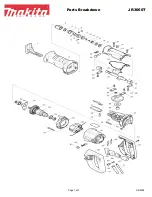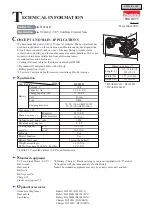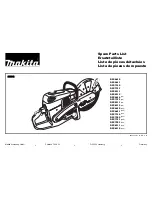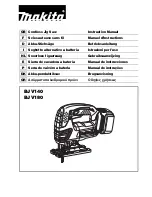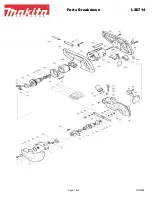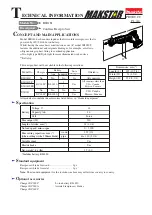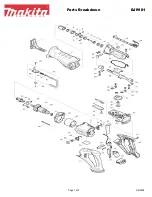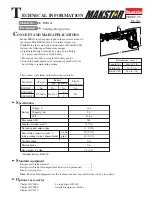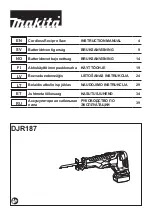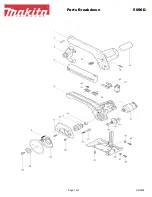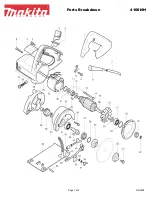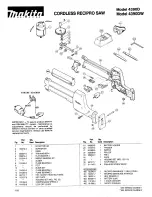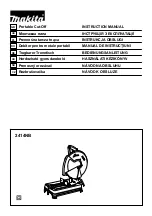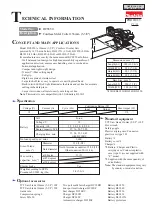
5 ENGLISH
Battery tool use and care
1.
Recharge only with the charger specified by
the manufacturer.
A charger that is suitable for
one type of battery pack may create a risk of fire
when used with another battery pack.
2.
Use power tools only with specifically desig
-
nated battery packs.
Use of any other battery
packs may create a risk of injury and fire.
3.
When battery pack is not in use, keep it away
from other metal objects, like paper clips,
coins, keys, nails, screws or other small metal
objects, that can make a connection from one
terminal to another.
Shorting the battery termi-
nals together may cause burns or a fire.
4.
Under abusive conditions, liquid may be ejected
from the battery; avoid contact. If contact acci-
dentally occurs, flush with water. If liquid contacts
eyes, additionally seek medical help.
Liquid ejected
from the battery may cause irritation or burns.
5.
Do not use a battery pack or tool that is damaged or
modified.
Damaged or modified batteries may exhibit unpre
-
dictable behaviour resulting in fire, explosion or risk of injury.
6.
Do not expose a battery pack or tool to fire or
excessive temperature.
Exposure to fire or tem
-
perature above 130 °C may cause explosion.
7.
Follow all charging instructions and do not
charge the battery pack or tool outside the
temperature range specified in the instruc
-
tions.
Charging improperly or at temperatures
outside the specified range may damage the
battery and increase the risk of fire.
Service
1.
Have your power tool serviced by a qualified
repair person using only identical replacement
parts.
This will ensure that the safety of the power
tool is maintained.
2.
Never service damaged battery packs.
Service
of battery packs should only be performed by the
manufacturer or authorized service providers.
3.
Follow instruction for lubricating and chang-
ing accessories.
Safety instructions for mitre saws
1.
Mitre saws are intended to cut wood or wood-
like products, they cannot be used with abra-
sive cut-off wheels for cutting ferrous material
such as bars, rods, studs, etc.
Abrasive dust
causes moving parts such as the lower guard to
jam. Sparks from abrasive cutting will burn the
lower guard, the kerf insert and other plastic parts.
2.
Use clamps to support the workpiece whenever
possible. If supporting the workpiece by hand,
you must always keep your hand at least 100
mm from either side of the saw blade. Do not
use this saw to cut pieces that are too small to
be securely clamped or held by hand.
If your
hand is placed too close to the saw blade, there is
an increased risk of injury from blade contact.
3.
The workpiece must be stationary and
clamped or held against both the fence and the
table. Do not feed the workpiece into the blade
or cut "freehand" in any way.
Unrestrained
or moving workpieces could be thrown at high
speeds, causing injury.
4.
Push the saw through the workpiece. Do not
pull the saw through the workpiece. To make
a cut, raise the saw head and pull it out over
the workpiece without cutting, start the motor,
press the saw head down and push the saw
through the workpiece.
Cutting on the pull stroke
is likely to cause the saw blade to climb on top
of the workpiece and violently throw the blade
assembly towards the operator.
5.
Never cross your hand over the intended line of
cutting either in front or behind the saw blade.
Supporting the workpiece "cross handed" i.e. hold-
ing the workpiece to the right of the saw blade with
your left hand or vice versa is very dangerous.
6.
Do not reach behind the fence with either hand
closer than 100 mm from either side of the saw
blade, to remove wood scraps, or for any other
reason while the blade is spinning.
The proxim-
ity of the spinning saw blade to your hand may not
be obvious and you may be seriously injured.
7.
Inspect your workpiece before cutting. If the
workpiece is bowed or warped, clamp it with
the outside bowed face toward the fence.
Always make certain that there is no gap
between the workpiece, fence and table along
the line of the cut.
Bent or warped workpieces
can twist or shift and may cause binding on the
spinning saw blade while cutting. There should be
no nails or foreign objects in the workpiece.
8.
Do not use the saw until the table is clear of all tools,
wood scraps, etc., except for the workpiece.
Small
debris or loose pieces of wood or other objects that con
-
tact the revolving blade can be thrown with high speed.
9.
Cut only one workpiece at a time.
Stacked multiple
workpieces cannot be adequately clamped or braced
and may bind on the blade or shift during cutting.
10.
Ensure the mitre saw is mounted or placed on
a level, firm work surface before use.
A level
and firm work surface reduces the risk of the mitre
saw becoming unstable.
11.
Plan your work. Every time you change the
bevel or mitre angle setting, make sure the
adjustable fence is set correctly to support the
workpiece and will not interfere with the blade
or the guarding system.
Without turning the tool
"ON" and with no workpiece on the table, move
the saw blade through a complete simulated cut to
assure there will be no interference or danger of
cutting the fence.
Содержание LS004GM201
Страница 43: ...43...





















